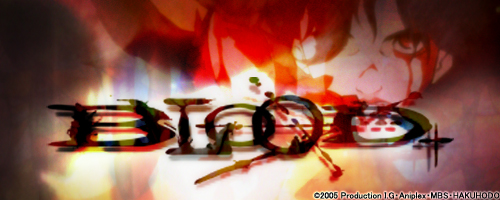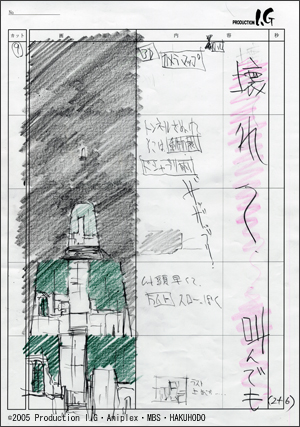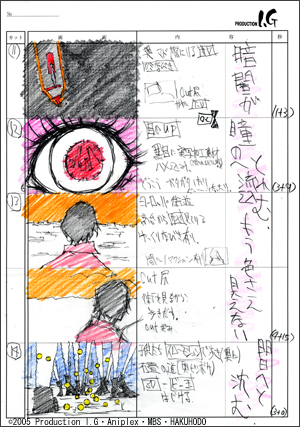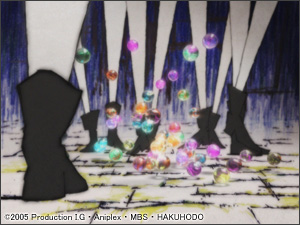Making of Blood+ OP 3 - Part 3: Computer Animation

TV series Blood+ eventually featured 4 different opening films, directed by different creators with totally different graphic styles. All films have a slight twist to the ordinary, but the third version, seen from episode 26, somehow stands on its own. This film of just 90 seconds, that was recently selected in competition for the 11th Holland Film Festival, obviously has an interesting production story behind it. So we have asked the staff to tell us more about their work. This third part of our exclusive interview is focusing on the computer graphics treatment in this apparently full-analog animation piece.
Staff Profiles
Naoyoshi Shiotani
Sequence and animation director. Born in 1977, he's one of Production I.G's most promising young creators. His main works include Windy Tales (2004) and Blood+ (2006), and served as key animator in a number of I.G works, such as Otogi Zoshi (2004), The Prince of Tennis - Two Samurai: The First Game (2005) and Tsubasa Chronicle - The Princess of the Birdcage Kingdom (2005). He's a soft-spoken nice guy with a naughty boy inside.
Atsushi Sato
3D animator. Born in 1978, he partecipates to many recent I.G's productions, from Innocence (2004) to IGPX (2005), Tsubasa Chronicle - The Princess of the Birdcage Land (2005) and Tachigui: The Amazing Lives of the Fast Food Grifters (2006). A passionate man who says, "It's not that I like to work, I just love doing 3D."
What got you to ask Sato-san to do the 3D work?
Shiotani: When we decided to do the opening sequences, I contacted him right away and told him, "you are the only one who could do it!" I knew Sato-san's 3D rendering was the closest to my ideas. You see, I first worked with him in IGPX.
Sato: The mission was to use Shiotani-san's drawings and move the background using camera mapping.
Can you tell us more about "camera mapping"?
Sato: We move the background we created in 3D to make it into a powerful animation. It looks as if you are seeing an illustration projected with a slide projector rather than on a flat surface. You can show a 2D illustration with depth even when the camera shoots from an angle.
What were the instructions for the opening sequence of Blood+?
Sato: Shiotani-san never gives specific instructions. (lol) But this time, he also did the storyboard, so I just followed what I found there.
Shiotani: For this sequence, I wanted, "the camera to speed through a tunnel close to the ground in a heavy rain; then slide around the zoo in a 3D environment and look up in a drizzling rain." I told the staff that I wanted this scene to be flashy. And use camera mapping to make the image powerful.

Sato: Usually, when we work on a scene, I ask the art section to draw the background. But for this work, we used a sketch draft of the zoo Shiotani-san drew for one episode in the TV series.
Shiotani: This was the background used in the main story, so we couldn't ask Kobayashi Production. We were also tight in terms of schedule.
Sato: In the series episode, the scene was set in a sunny day, so we had to recreate the sky. We tried something similar for the feature film, Tsubasa Chronicle - The Princess of the Birdcage Land. We made the background for 4 - 5 scenes that looked like a jigsaw puzzle. The camera angle changed tremendously, so we couldn't order all the background we needed. The amount would have been enormous. So what we did was to take background from other scenes and added to the scenes after the key animation was arranged; then we checked to see if the background flowed well. This is how Shiotani-san works; "just do it." (lol) Squeeze in by force and arrange according to their requests. I like that too, you know. We can add fun things every time.
Shiotani: The rain after the tunnel was also 3D.
What do you mean by "the rain was in 3D"?
Sato: We drop a lot of long and thin rods we made in 3D. It does not look much different from traditional "hand-drawn" rain, but the greatest advantage is that we can easily cater to situations when the camera angle changes. Until now, rain was created by 2D animators. But this time, Shiotani-san said, "nope, we will do rain in 3D."
Shiotani: Surely I could have asked the animators to do the rain if it was just that scene, but you know, when the camera is aimed up, the rain appears to fall in a different direction. I really wanted that.
Sato: Initially, I got worried I might not be able to do it, but Shiotani-san gave such instructions that I felt we might just be able to accomplish it with a little twist. It was a good chance to do new stuff, so I didn't want to say, "we can't do that."
Shiotani: I know Sato-san will spread out and do it for me despite his busy schedule, so I presume he would do it and draw storyboards accordingly. A regular opening sequence uses camera work such as panning. I did not want that for this work. Basically, I used fixed drawings and where I wanted them highlighted, I used 3D movements to add strength to the picture.
You are putting so much into three seconds.
Shiotani: To tell you the truth, the hardest part was the scene with marbles.
Sato: The layout of that scene was decided ahead of other scenes, actually.
Shiotani: The storyboard was detailed enough to be used as the scene's layout, so I asked the 3D team to start working taking the enlarged frames on the storyboard as reference. With the finished 3D, I drew the key animation myself.

Sato: 3D has an advantage in rendering shiny things and glass texture, and I love to work with shiny things, so I was able to do it in a short time. I should add that Shiotani-san seemed to know what I wanted to do. (lol)
Shiotani: I didn't mind the 3D not blending well with the rest in this scene. I really wanted the marbles to stand out. For that reason, I faded the colors of all the characters and the background.

The movements of the marbles were delightful too.
Shiotani: It took a while to obtain the right movement, amount, and spreading span of the marbles to suit the image I had in mind.
Sato: We had decided from the beginning to use slow motion in the middle. But every single movement changed when we tried to apply the texture and the span of the spreading marbles according to Shiotani-san's image. We had to adjust that every time, so it took us a long time. In between these, we worked on the texture of the marbles as well. We put in several layers including the lighting material.
Shiotani: We meticulously transferred the background image in each of the marbles, too. If you pay attention, you may notice that the background is reflected into the marbles.
Sato: But nobody can notice that just watching the film on a standard TV screen at home! (tears)
Shiotani: OK, maybe it is not so immediate... but this made the marbles look clearer and blend into the surroundings.
Sato: It's like we do it because we want to even though you can notice it on the TV screen. I'll tell you another secret: the bows in the marbles actually rotate in the marbles too!
Shiotani: People say the slow-motion part where the marbles spread was impressive. You may call it subliminal, but I do not think it has been a waste of time.
Sato: When a marble is up in the air, its shadow on the ground is black, but when the marble drops, the light gathers around the marble and its shadow is white in the middle. Actually, there is a way to calculate it in 3D, but that would take too long, so people make a good excuse not to. People won't notice that in a matter of a second (lol), but I wanted to do it anyway because I knew that the whole scene would really look cool.
Shiotani: We went through a few retakes, but this scene improved tremendously at each step.
Sato: It would be stressful if we couldn't sense that we were progressing. It might be that it's good for me to overdo things.
Shiotani: Whatever I asked Sato-san to do for me, he had the ability not just to make it but also to improve it without further indications from my side. When I told him what I wanted, I could see that he had the final image already in his head. It is true in drawings too. It doesn't matter how much you draw. You must have the final image in your head to do a good job.
(3 - continues)

![WORK LIST[DETAILS]](/contents/works/design/images/left_title.gif)



 terms of use
terms of use